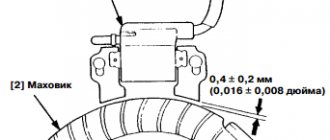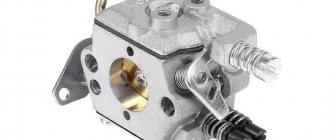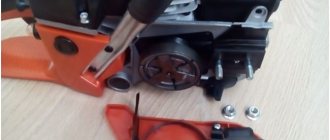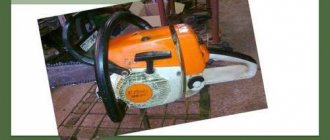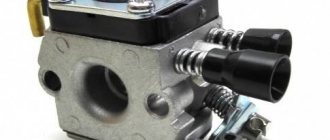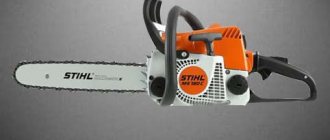When should it be adjusted?
First, you need to decide why you might need to adjust and repair the Stihl ms 180 carburetor. So, this needs to be done in the following cases:
- If the chainsaw does not hold idle speed;
- repairs may be required if the saw does not start;
- there is a loss of power;
- increased fuel consumption;
- the chainsaw does not develop maximum speed;
- stalls when revving up.
This list can be continued for a long time, but we have identified the main reasons. Before you start making adjustments, you need to know what main parts the carburetor on the Shtil MC 180 chainsaw consists of, and who makes it.
What carburetor is installed on the Shtil 180 chainsaw
Carburetor mounted on a Shtil 180 chainsaw
According to the site prokarbyrator.ru, the Shtil 180 chainsaw is equipped with a Japanese membrane-type carburetor from Zama. And although they are assembled in China, Zama is owned by Stihl.
There are Chinese analogues on the market that are noticeably cheaper than the original ones. Lower price, lower quality. Although the carburetor body bears the “Made in China” stamp, the company’s quality control guarantees high reliability and offers an additional guarantee for its products.
The original carburetors have the company logo on the body.
How to adjust it yourself, the nuances of setting
The carburetor of the Shtil 180 chainsaw, indiscriminately, can only be adjusted by the number of revolutions at idle. It is impossible to increase or decrease the fuel supply in various modes using special screws. The manufacturer limits access to adjustments and does not install these screws. How to adjust the carburetor to the correct idle speed is described in great detail in the manufacturer's instructions.
If certain malfunctions occur, and if you have experience, you can increase or decrease the fuel supply by increasing the gap when opening the needle valve.
To increase the flow, the rocker arm of the needle valve in the distribution chamber must be bent up, and to decrease, down. This regulates the stroke of the needle and, accordingly, the throughput of the valve.
You should not carry out the adjustment yourself, because this must be done very precisely and if there is an error, it is almost impossible to return the original position of the rocker arm.
Preparation for tuning, carburetor parts for its implementation and safety precautions
Before adjusting the UPT, you must make sure that both filters (air and fuel) are clean. In addition, there should be no air leakage into the engine from the side (through the seals, the gasket under the UPT or its accelerator pump, or anywhere else), otherwise it will not be possible to adjust the carburetor.
Preparing to adjust the carburetor
Almost any UPT is adjusted with 3 screws:
- The main jet bolt, designated "H" and used to set the maximum speed of the saw motor.
- The idle jet bolt, designated "L" and used to set low speed. That is, to regulate idle speed.
- The idle adjustment bolt, designated in various cases, “LA” (Stihl), “T” (Partner, Husqvarna).
There are also carburetors with fewer adjustment screws. In this way, manufacturers protect their products from unprofessional intervention and at the same time try to simplify their setup.
For safe regulation during its implementation, the following rules should be followed:
- The tool must be firmly installed on a flat surface of a rigidly fixed object (workbench, rack, table).
- The chain should be directed away from yourself and others present.
- There must be a safe distance between the chain and any surrounding objects to ensure that they cannot come into contact.
Malfunctions and repairs
After we have examined the design of the carburetor, it is not difficult to determine the reason why fuel enters the combustion chamber in a larger volume. This happens due to wear of the gasket between the compensator cover and the carburetor body. How might this make an impact, you ask?
The answer is simple: as the gasket contracts, it releases the diaphragm on top of it a fraction of a millimeter down. This, in turn, will put more pressure on the needle valve rocker arm, it will open more than it should and fuel will flow in excess (it will begin to overflow).
Another reason is stretching of the diaphragm itself, this occurs as a result of natural wear and tear. It is impossible to prevent this process, but you can solve the problem by periodically changing all gaskets, carburetor diaphragms, and fuel pumps. There is a repair kit for this.
When cleaning a chainsaw with compressed air, never blow into the fuel pipe, as this can stretch the diaphragm.
Sticking injector valve - a common breakdown and how to avoid it?
A common cause of carburetor failure on a Stihl chainsaw is a stuck valve in the nozzle. The reason for sticking is a violation of the storage of the chainsaw, or rather the Shtil 180 manufacturer’s instructions for proper preparation for storage.
As follows from the instructions, before long-term storage, it is necessary to drain the fuel from the tank, then start the saw and burn off the gasoline from the carburetor. Failure to comply with this elementary rule entails the following consequences. The forsknui valve, being in direct contact with the fuel, sticks to the body, because the gasoline gradually evaporates and only sticky oil remains. You cannot replace the injector, since they are not in the repair kit; you can only try to knock it out and wash it, which is not always possible to do without damaging the injector.
Specifications
The Stihl MS-660 professional chainsaw is equipped with a fifty-one cm variable bar and a spare chain. Replacing parts is quick, which makes it possible to work with thick trunks and then cut out branches.
The Chinese chainsaw has the following characteristics:
- Power 7.1 hp (5.22 kW)
- Engine capacity 91.6 cm³;
- Chain saw pitch nine mm;
- Chain thickness 1.6 cm;
- Number of links in chains 72, 90, 162;
- Fuel consumption 0.4-0.8 l/h;
- Fuel tank capacity 0.83 l
- Oil tank capacity 0.36 l
- Tire length 40, 50, ninety cm;
- Weight fully charged 7.3 kg.
Specifications may vary slightly as manufacturers make changes and modifications to their products.
Design and principle of operation
So, the carburetor was developed and manufactured by a subsidiary of Stihl, called Zama. Original carburetors have the company logo on their body, guaranteeing product quality.
Appearance of the Zama carburetor
Fuel pump
A fuel pump is installed directly in the carburetor body, which operates under the influence of an air pulse from the chainsaw crankcase, transmitted through special channels. The pump has a diaphragm installed, which is responsible for pumping fuel under the influence of an impulse. A gasket is installed between the diaphragm and the housing, which is responsible for the tightness of the fuel pump.
Distribution chamber
In the distribution chamber, as in the fuel pump, there is also a membrane that opens and regulates the fuel supply by pressing a special rocker arm, which lifts its needle valve.
The chamber cover is the compensator body, which is attached to the carburetor using four screws; a gasket is installed between the body and the cover, which increases the height of the chamber and is responsible for sealing.
Nozzle
The fuel supply nozzle is mounted in the carburetor body in such a way that it is a connecting link between the distribution chamber and the cavity in which the throttle valve is installed. At the same time as the fuel, air is supplied to the injector and an air mixture is formed. The injector has a check valve that blocks the flow of air in the reverse order, that is, from the throttle chamber to the distribution chamber.
Throttle valve
The throttle valve is installed in the carburetor body and is responsible for increasing the flow of the fuel mixture directly into the engine cylinder. At the moment you press the gas, the throttle valve opens slightly, thereby increasing the throughput of the channel and fuel from the carburetor cavity rushes into the cylinder in a larger volume.
Combustion of a larger volume of fuel increases the amount of energy generated, which affects the power and speed of processes. The damper is installed on a shaft passing through the entire carburetor body. At the shaft exit from the housing, there is a fastening for the throttle cable, and next to it there is a cone-shaped adjusting screw responsible for adjusting the idle speed. By tightening the screw, you can slightly adjust the position of the shaft and the damper installed on it, thereby increasing or decreasing the idle speed, slightly opening or vice versa closing the damper.
Air damper
The carburetor air damper is installed on the opposite side of the throttle valve and is responsible for starting a cold engine; it is controlled by the engine control lever. For a cold start, the air damper is completely closed; for normal operation, it is opened.
In the photo, there is a hole in the center, and there is a washer in the middle - this is the air damper
Model specifications
The advantages of this household garden tool include good factory parameters, which allow the model to be used for work under increased loads.
The main characteristics of the chainsaw include:
- engine power – 2.7 liters. s./2 kW;
- cylinder volume – 40.2 cm3;
- idle/maximum speed – 2800/10000 rpm;
- permissible length of the installed tire is 30–35 cm;
- the recommended pitch of the chain used is 3/8 “;
- vibration right/left – 6.9/8.9 m/s2;
- noise level during operation – 113 dB.
The Stihl MS 230 C BE 16 chainsaw has a modest weight - with full tanks and an installed saw set, the model weighs 4.6 kg.
How to remove and reinstall?
In cases where it is necessary to clean the Shtil 180 carburetor or disassemble it, you will first need to remove the assembly from the chainsaw. This must be done in compliance with a certain algorithm of actions:
- Place the protective cover for the chainsaw on the bar.
- Remove the top cover of the chainsaw.
- Unscrew the two nuts securing the air filter and carburetor.
- Remove the air filter housing.
- Disconnect the wire from the engine control lever.
- Carefully remove the lever from its seat in the housing, while simultaneously disconnecting the air damper rod from it.
- Pull the carburetor towards you and disconnect the fuel supply, as well as the throttle linkage.
To facilitate dismantling, you can additionally unscrew the rear handle and disconnect the throttle linkage first from it, and then only from the carburetor. This may be necessary, because without some experience, disconnecting the rod from the carburetor is quite problematic and it is easier to first disassemble the handle.
To install the part in place, follow the reverse order of the algorithm.
When removing and installing the chainsaw engine control lever, you should be extremely careful, because the seat on the saw body is the weak link of the saw, and very often inexperienced users break it.
The saw does not start: reasons and solutions
It's either sucking air somewhere, or something is clogged.
The main ways to troubleshoot a STIHL MS 180 chainsaw are to disassemble, wash and bleed the carburetor, change the fuel filter in the tank, check the fuel hoses for cracking (they can suck in air). There is only one adjusting screw on the carburetor - idle speed (it happens that you turn it and the chainsaw started working again). The connection between the carburetor and the cylinder, in terms of air suction, is reliable - there is a plastic ring there (no gaskets are needed).
Immediately after starting, the chainsaw operates at high speeds, and if you press the gas, instead of starting to accelerate, it “chokes” and even stalls. Or it starts poorly, does not pick up speed and stalls (this chainsaw malfunction also applies to other expensive chainsaws with an accelerator pump in the carburetor).
Cause of chainsaw malfunction: Wear of the rubber cuff on the piston of the accelerator pump in the carburetor (fuel accelerator). This leads to air leakage from the accelerator pump and the main jet supplies a lean fuel-air mixture (there is little gasoline in the mixture) into the diffuser, and the chainsaw first operates at high speeds, and then “chokes” and stalls. This happens after 2-3 years of operation and usually happens in the hot summer months.
Remove the carburetor from the chainsaw. Remove the fuel pump cover with the membrane by unscrewing one screw in the center of the cover. Next, turn the carburetor towards you with the throttle valve, on the side where there are two holes, in one you can see a pin, and under it there is an accelerator pump. Remove the retaining ring from the outside of the pin and disconnect the wire spring of the air damper.
Unscrew the screw in the center of the throttle valve, remember how the throttle valve is positioned (so that you can put it that way later) and remove the throttle valve. Plug the hole with the pin with your finger (the accelerator is spring-loaded and if you remove the throttle axis and do not close the hole, the accelerator will pop out), then turn the throttle axis and remove it.
Shake the accelerator (piston) with the spring out of the hole. There is a rubber cuff (ring) on the piston - its wear is what causes the chainsaw to malfunction. It is necessary to replace the piston with a rubber cuff and a spring (they are sold as a repair kit). Or you can remove the worn piston with the spring, and plug the hole by pushing a rubber plug in there (the chainsaw will not have an accelerator pump, that is, it will accelerate not in 3 seconds, but in 4 seconds, but it will work well since there will be no suction air from the carburetor).
Assembly after troubleshooting the chainsaw (after eliminating the malfunction of the chainsaw carburetor) is carried out in the reverse order of disassembly. When assembling the throttle valve, before tightening the screw, the throttle valve itself must be positioned correctly so that it does not jam, and the threads of the screw securing the throttle valve to the axle should be degreased and coated with a special thread sealant (sold in small tubes, red, liquid) or flattened with pliers, because if this bolt gets unscrewed during operation, it goes straight into the cylinder) and repair or replacement of the piston cannot be avoided). So we looked at how to fix this chainsaw problem.
, it is worth noting the fact that the 180th saw of this manufacturer is one of the best in its “creations”, but also has its drawbacks. Actually, what we are talking about now.
Brief video instructions for replacing membranes in a chainsaw carburetor.
The chainsaw does not start, the spark plugs are flooded, what should I do? Vkontakte community:.
Currently reading: Chainsaw power calm 180
When a spark plug on a chainsaw is poured, you must immediately conduct a thorough check of the tool.
- Checking the plug. Part of regular maintenance of your Stihl chain saw is to remove the fork and inspect it (every 10 to 15 hours of operation is recommended.) If the motor is running normally, the outer electrode will likely be covered in light brown deposits. The operator must check the gap between the electrodes using a special tool. If the engine is running normally, the problem appears in the condition of the plug. Thick black deposits indicate that the fuel/air mixture is not balanced. In other words, there is not enough air in the mixture. On the other hand, wide gaps or corroded electrodes are indicators of a lean mixture. Oil on the plug indicates a leak.
- Clean or replace? If the fork is coated with light brown deposits and the clearance is correct, the operator does not need to do anything to the fork. It is enough to return it to its place, and the chainsaw should continue to work normally. If it is covered with black deposits or oil, you need to remove this layer with sandpaper. If necessary, adjust the gap with pliers. One of the conditions indicating the need for replacement is electrode wear. If the engine stalls, you need to check it with a spark plug tester and replace it if the spark is not strong or appears every once in a while.
Related Posts
A short video instruction on replacing membranes in a chainsaw carburetor.
First of all, it is worth noting the fact that the 180 chainsaw of this manufacturer is one of his best “creations”, but it also has its drawbacks. Actually, which we will talk about now.
How to disassemble for cleaning and replacing the repair kit?
In order to clean, change gaskets or needle valve, the carburetor must be disassembled. To do this, you need to unscrew 4 screws on the compensator cover and one on the fuel pump.
Once you open the housing, you should be extremely careful, because if debris gets inside the carburetor, it will make it impossible to operate. The thickness of the channels in it is comparable to the thickness of a thread or even a human hair.
A video on repairing a Shtil 180 carburetor can be viewed below. In it, the master talks in detail about the problems and clearly demonstrates the entire repair process.
Preparation for self-tuning of fuel equipment
The sequence for adjusting the carburetor is outlined in the attached operating instructions. The factory kit includes a screwdriver for adjusting the screws marked with the letters L, H and T. Some manufacturers equip their chainsaws with carburetors, the adjustment of which requires a special adjustment key.
Read also: How to solder wires together with a soldering iron
Correct tuning of the fuel system requires warming up the power unit to operating temperature and pre-cleaning the air intake filter element. The saw is installed in a position that provides convenient access to the fuel equipment.
Related Posts
The need for the operation “Adjusting the chainsaw carburetor” is determined by the color of the spark plug electrodes: if they are black, it means over-enrichment, if they are brick-gray, it means normal, if there is a snow-white coating on the electrodes of the spark plug, it means the mixture is lean. The main role in adjusting the carburetor of the Stihl chainsaw is played by the upper screw (closest to the muffler). According to the factory specifications (indicated on the lid of the chainsaw), it must be unscrewed 1 turn, and then it needs to be adjusted - if you unscrew it, the working mixture becomes richer (more than just gasoline gets into the air-fuel mixture), if such a screw is screwed in, then the working mixture becomes leaner (less gasoline gets into the air-fuel mixture).
Before adjusting the carburetor of the Stihl chainsaw, you need to carry out technical service of the chainsaw (clean the carburetor of the chainsaw, rinse the chainsaw engine, change the spark plug, clean the air filter, check the chain tension, adjust the idle speed, warm up the engine). See also: Banks of Kremenchug. Let's continue with the adjustment:
1. Screws “H” and “L” (on a switched off chainsaw) are fully tightened, and then unscrew both by 1 turn. 3.2. Start the chainsaw and warm it up. Give full throttle and use screw “H” to reach the highest engine speed of 14,000 rpm. by tachometer (by engine revolution counter). Keep the highest speed for adjustment for no more than 10 seconds! 3. Use the “LA” bolt to reach the idle stop so that the chain begins to move, and finally turn the bolt ¼ turn counterclockwise.

